CHEVROLET COBALT 2008 1.G Owners Manual
Manufacturer: CHEVROLET, Model Year: 2008, Model line: COBALT, Model: CHEVROLET COBALT 2008 1.GPages: 402, PDF Size: 2.15 MB
Page 321 of 402
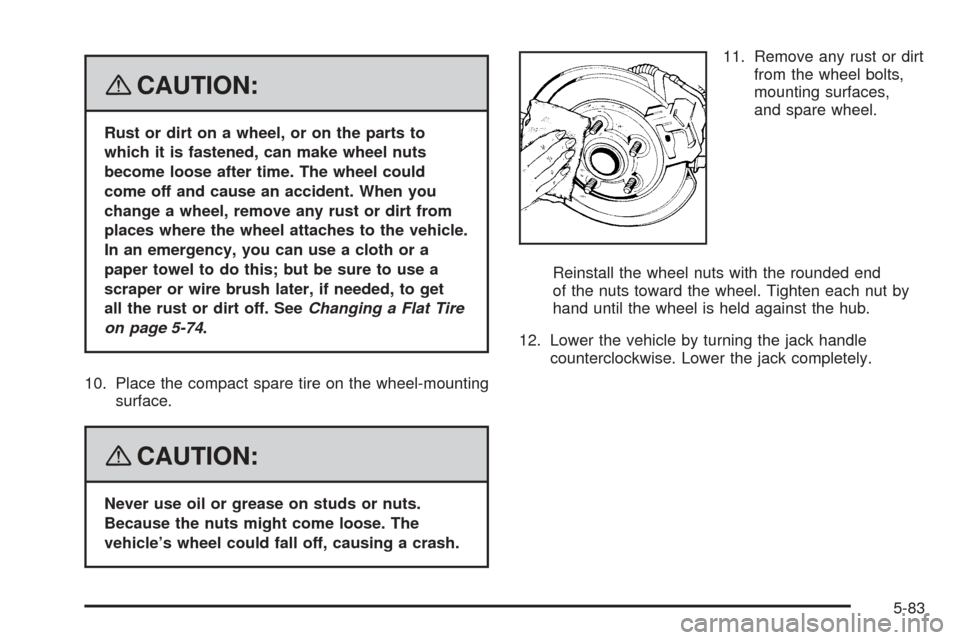
{CAUTION:
Rust or dirt on a wheel, or on the parts to
which it is fastened, can make wheel nuts
become loose after time. The wheel could
come off and cause an accident. When you
change a wheel, remove any rust or dirt from
places where the wheel attaches to the vehicle.
In an emergency, you can use a cloth or a
paper towel to do this; but be sure to use a
scraper or wire brush later, if needed, to get
all the rust or dirt off. SeeChanging a Flat Tire
on page 5-74.
10. Place the compact spare tire on the wheel-mounting
surface.
{CAUTION:
Never use oil or grease on studs or nuts.
Because the nuts might come loose. The
vehicle’s wheel could fall off, causing a crash.11. Remove any rust or dirt
from the wheel bolts,
mounting surfaces,
and spare wheel.
Reinstall the wheel nuts with the rounded end
of the nuts toward the wheel. Tighten each nut by
hand until the wheel is held against the hub.
12. Lower the vehicle by turning the jack handle
counterclockwise. Lower the jack completely.
5-83
Page 322 of 402
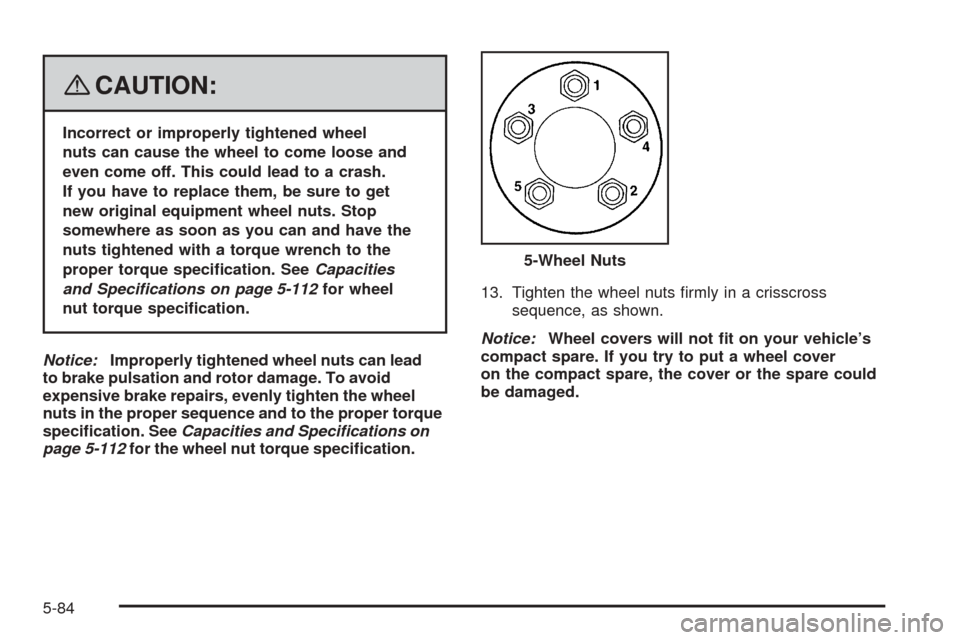
{CAUTION:
Incorrect or improperly tightened wheel
nuts can cause the wheel to come loose and
even come off. This could lead to a crash.
If you have to replace them, be sure to get
new original equipment wheel nuts. Stop
somewhere as soon as you can and have the
nuts tightened with a torque wrench to the
proper torque speci�cation. SeeCapacities
and Specifications on page 5-112for wheel
nut torque speci�cation.
Notice:Improperly tightened wheel nuts can lead
to brake pulsation and rotor damage. To avoid
expensive brake repairs, evenly tighten the wheel
nuts in the proper sequence and to the proper torque
speci�cation. SeeCapacities and Specifications on
page 5-112for the wheel nut torque speci�cation.13. Tighten the wheel nuts �rmly in a crisscross
sequence, as shown.
Notice:Wheel covers will not �t on your vehicle’s
compact spare. If you try to put a wheel cover
on the compact spare, the cover or the spare could
be damaged.5-Wheel Nuts
5-84
Page 323 of 402
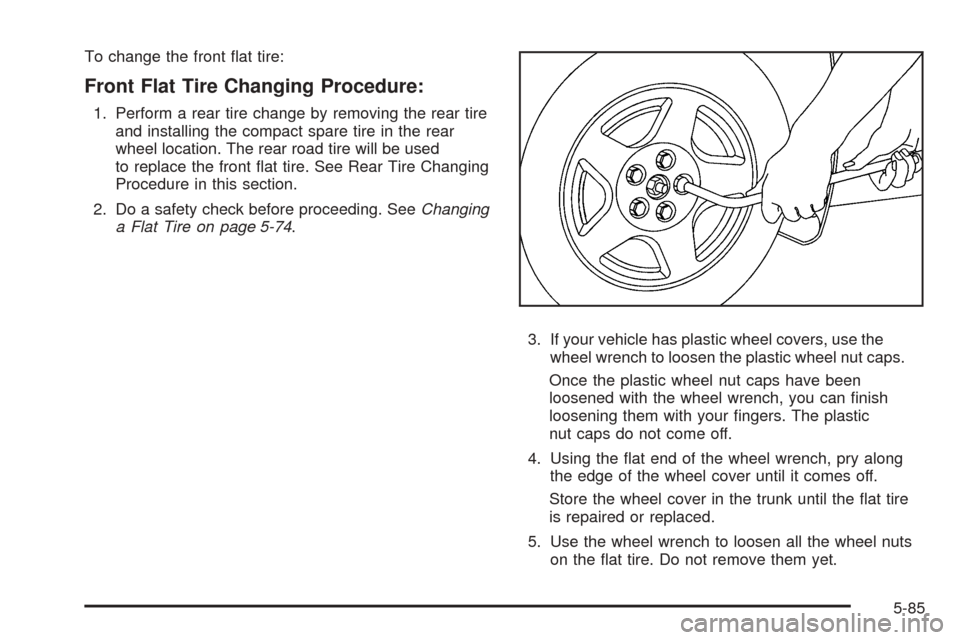
To change the front �at tire:
Front Flat Tire Changing Procedure:
1. Perform a rear tire change by removing the rear tire
and installing the compact spare tire in the rear
wheel location. The rear road tire will be used
to replace the front �at tire. See Rear Tire Changing
Procedure in this section.
2. Do a safety check before proceeding. SeeChanging
a Flat Tire on page 5-74.
3. If your vehicle has plastic wheel covers, use the
wheel wrench to loosen the plastic wheel nut caps.
Once the plastic wheel nut caps have been
loosened with the wheel wrench, you can �nish
loosening them with your �ngers. The plastic
nut caps do not come off.
4. Using the �at end of the wheel wrench, pry along
the edge of the wheel cover until it comes off.
Store the wheel cover in the trunk until the �at tire
is repaired or replaced.
5. Use the wheel wrench to loosen all the wheel nuts
on the �at tire. Do not remove them yet.
5-85
Page 324 of 402
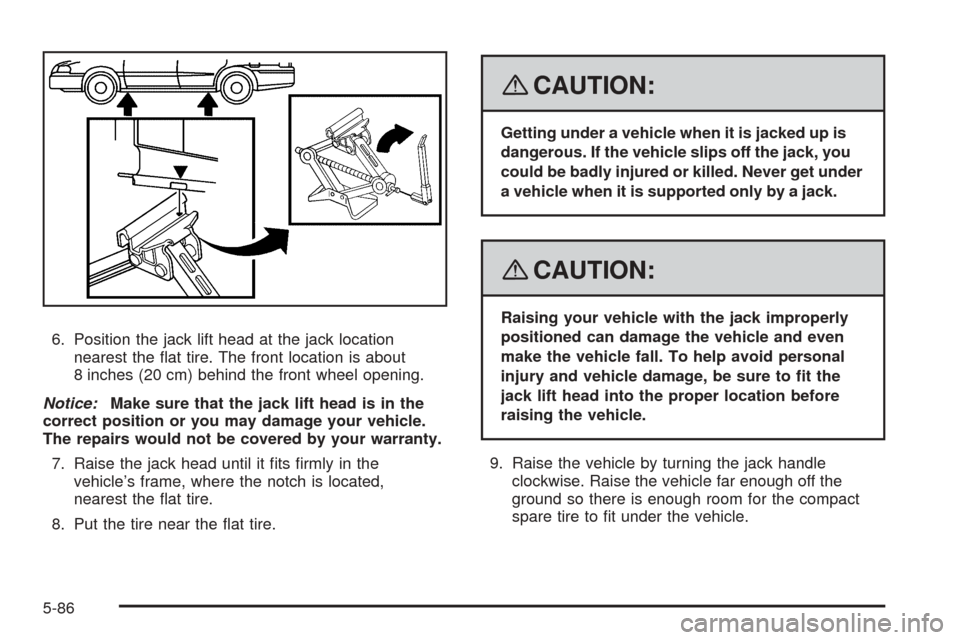
6. Position the jack lift head at the jack location
nearest the �at tire. The front location is about
8 inches (20 cm) behind the front wheel opening.
Notice:Make sure that the jack lift head is in the
correct position or you may damage your vehicle.
The repairs would not be covered by your warranty.
7. Raise the jack head until it �ts �rmly in the
vehicle’s frame, where the notch is located,
nearest the �at tire.
8. Put the tire near the �at tire.
{CAUTION:
Getting under a vehicle when it is jacked up is
dangerous. If the vehicle slips off the jack, you
could be badly injured or killed. Never get under
a vehicle when it is supported only by a jack.
{CAUTION:
Raising your vehicle with the jack improperly
positioned can damage the vehicle and even
make the vehicle fall. To help avoid personal
injury and vehicle damage, be sure to �t the
jack lift head into the proper location before
raising the vehicle.
9. Raise the vehicle by turning the jack handle
clockwise. Raise the vehicle far enough off the
ground so there is enough room for the compact
spare tire to �t under the vehicle.
5-86
Page 325 of 402
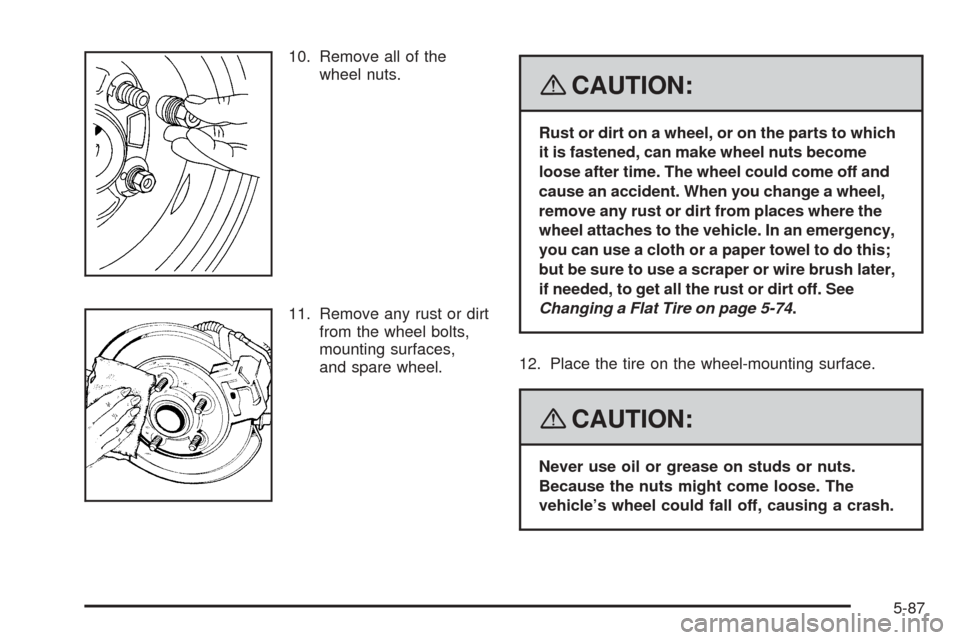
10. Remove all of the
wheel nuts.
11. Remove any rust or dirt
from the wheel bolts,
mounting surfaces,
and spare wheel.
{CAUTION:
Rust or dirt on a wheel, or on the parts to which
it is fastened, can make wheel nuts become
loose after time. The wheel could come off and
cause an accident. When you change a wheel,
remove any rust or dirt from places where the
wheel attaches to the vehicle. In an emergency,
you can use a cloth or a paper towel to do this;
but be sure to use a scraper or wire brush later,
if needed, to get all the rust or dirt off. See
Changing a Flat Tire on page 5-74.
12. Place the tire on the wheel-mounting surface.
{CAUTION:
Never use oil or grease on studs or nuts.
Because the nuts might come loose. The
vehicle’s wheel could fall off, causing a crash.
5-87
Page 326 of 402
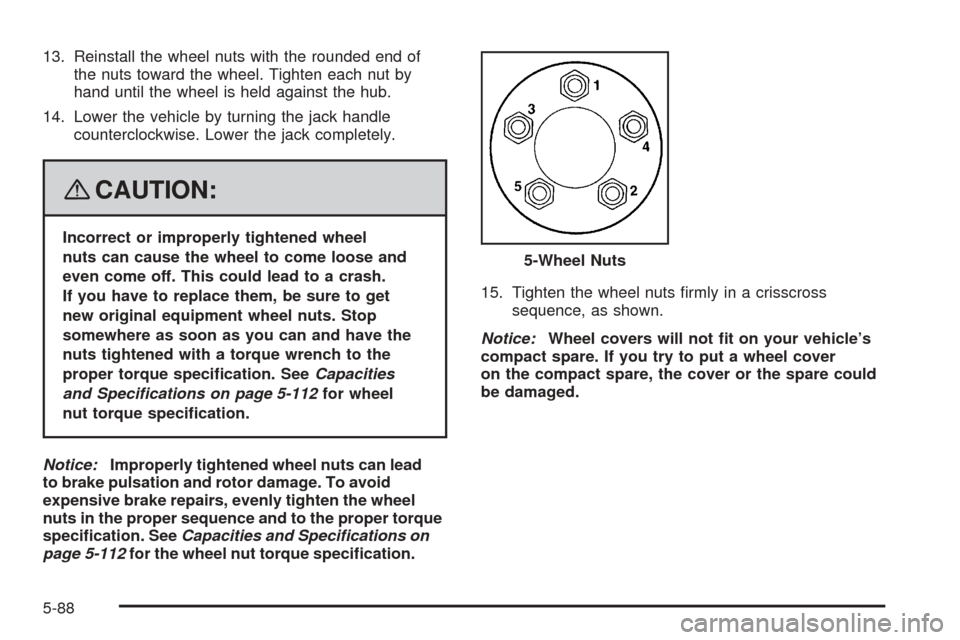
13. Reinstall the wheel nuts with the rounded end of
the nuts toward the wheel. Tighten each nut by
hand until the wheel is held against the hub.
14. Lower the vehicle by turning the jack handle
counterclockwise. Lower the jack completely.
{CAUTION:
Incorrect or improperly tightened wheel
nuts can cause the wheel to come loose and
even come off. This could lead to a crash.
If you have to replace them, be sure to get
new original equipment wheel nuts. Stop
somewhere as soon as you can and have the
nuts tightened with a torque wrench to the
proper torque speci�cation. SeeCapacities
and Specifications on page 5-112for wheel
nut torque speci�cation.
Notice:Improperly tightened wheel nuts can lead
to brake pulsation and rotor damage. To avoid
expensive brake repairs, evenly tighten the wheel
nuts in the proper sequence and to the proper torque
speci�cation. SeeCapacities and Specifications on
page 5-112for the wheel nut torque speci�cation.15. Tighten the wheel nuts �rmly in a crisscross
sequence, as shown.
Notice:Wheel covers will not �t on your vehicle’s
compact spare. If you try to put a wheel cover
on the compact spare, the cover or the spare could
be damaged.5-Wheel Nuts
5-88
Page 327 of 402
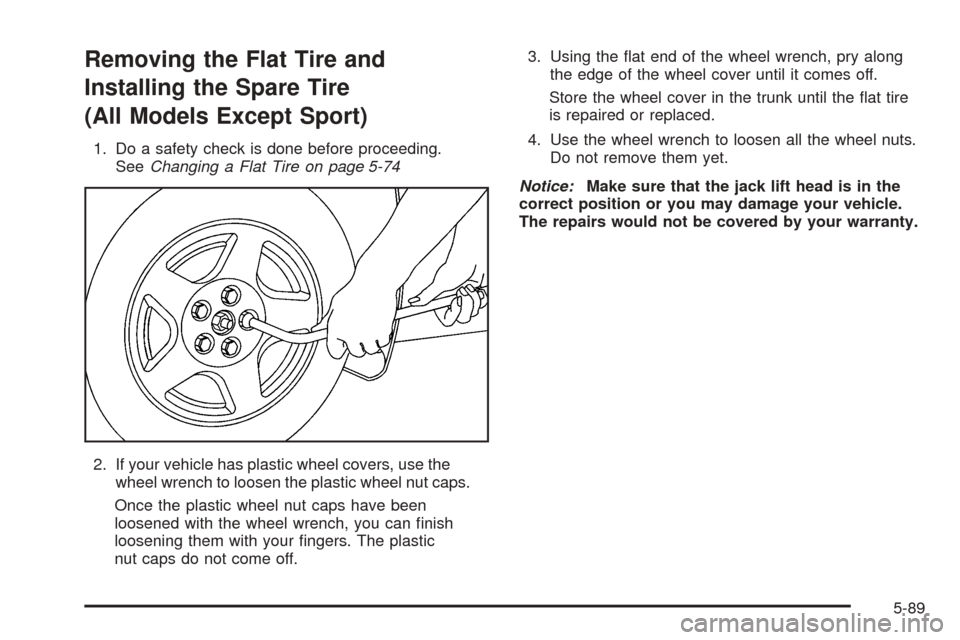
Removing the Flat Tire and
Installing the Spare Tire
(All Models Except Sport)
1. Do a safety check is done before proceeding.
SeeChanging a Flat Tire on page 5-74
2. If your vehicle has plastic wheel covers, use the
wheel wrench to loosen the plastic wheel nut caps.
Once the plastic wheel nut caps have been
loosened with the wheel wrench, you can �nish
loosening them with your �ngers. The plastic
nut caps do not come off.3. Using the �at end of the wheel wrench, pry along
the edge of the wheel cover until it comes off.
Store the wheel cover in the trunk until the �at tire
is repaired or replaced.
4. Use the wheel wrench to loosen all the wheel nuts.
Do not remove them yet.
Notice:Make sure that the jack lift head is in the
correct position or you may damage your vehicle.
The repairs would not be covered by your warranty.
5-89
Page 328 of 402
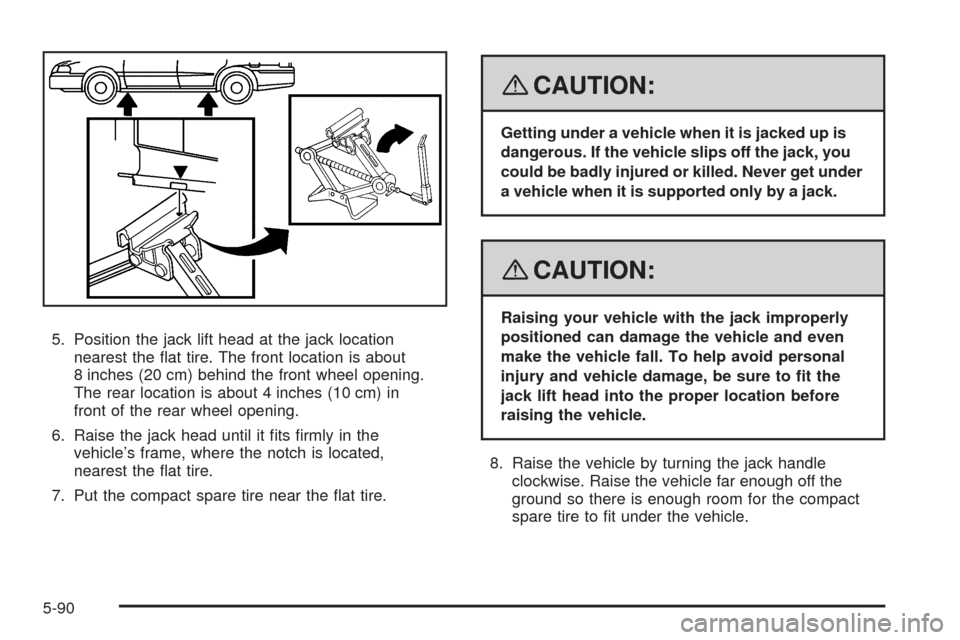
5. Position the jack lift head at the jack location
nearest the �at tire. The front location is about
8 inches (20 cm) behind the front wheel opening.
The rear location is about 4 inches (10 cm) in
front of the rear wheel opening.
6. Raise the jack head until it �ts �rmly in the
vehicle’s frame, where the notch is located,
nearest the �at tire.
7. Put the compact spare tire near the �at tire.
{CAUTION:
Getting under a vehicle when it is jacked up is
dangerous. If the vehicle slips off the jack, you
could be badly injured or killed. Never get under
a vehicle when it is supported only by a jack.
{CAUTION:
Raising your vehicle with the jack improperly
positioned can damage the vehicle and even
make the vehicle fall. To help avoid personal
injury and vehicle damage, be sure to �t the
jack lift head into the proper location before
raising the vehicle.
8. Raise the vehicle by turning the jack handle
clockwise. Raise the vehicle far enough off the
ground so there is enough room for the compact
spare tire to �t under the vehicle.
5-90
Page 329 of 402
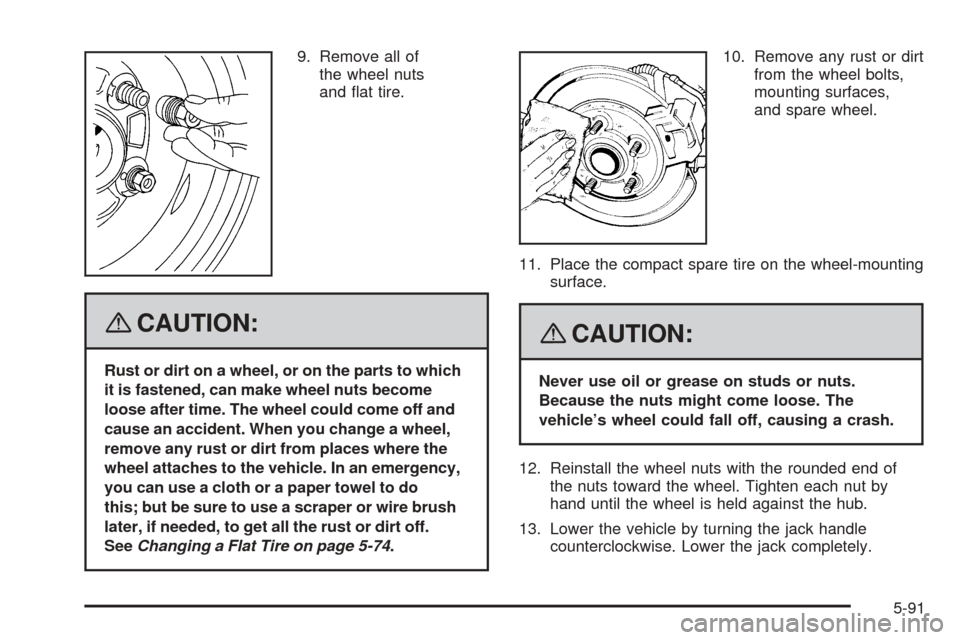
9. Remove all of
the wheel nuts
and �at tire.
{CAUTION:
Rust or dirt on a wheel, or on the parts to which
it is fastened, can make wheel nuts become
loose after time. The wheel could come off and
cause an accident. When you change a wheel,
remove any rust or dirt from places where the
wheel attaches to the vehicle. In an emergency,
you can use a cloth or a paper towel to do
this; but be sure to use a scraper or wire brush
later, if needed, to get all the rust or dirt off.
SeeChanging a Flat Tire on page 5-74.10. Remove any rust or dirt
from the wheel bolts,
mounting surfaces,
and spare wheel.
11. Place the compact spare tire on the wheel-mounting
surface.
{CAUTION:
Never use oil or grease on studs or nuts.
Because the nuts might come loose. The
vehicle’s wheel could fall off, causing a crash.
12. Reinstall the wheel nuts with the rounded end of
the nuts toward the wheel. Tighten each nut by
hand until the wheel is held against the hub.
13. Lower the vehicle by turning the jack handle
counterclockwise. Lower the jack completely.
5-91
Page 330 of 402
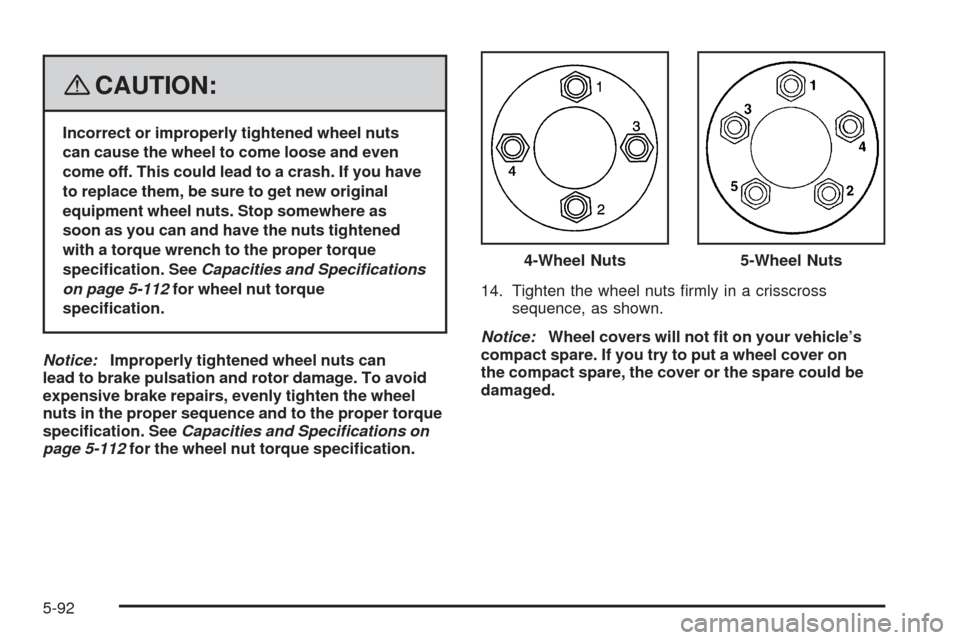
{CAUTION:
Incorrect or improperly tightened wheel nuts
can cause the wheel to come loose and even
come off. This could lead to a crash. If you have
to replace them, be sure to get new original
equipment wheel nuts. Stop somewhere as
soon as you can and have the nuts tightened
with a torque wrench to the proper torque
speci�cation. SeeCapacities and Specifications
on page 5-112for wheel nut torque
speci�cation.
Notice:Improperly tightened wheel nuts can
lead to brake pulsation and rotor damage. To avoid
expensive brake repairs, evenly tighten the wheel
nuts in the proper sequence and to the proper torque
speci�cation. SeeCapacities and Specifications on
page 5-112for the wheel nut torque speci�cation.14. Tighten the wheel nuts �rmly in a crisscross
sequence, as shown.
Notice:Wheel covers will not �t on your vehicle’s
compact spare. If you try to put a wheel cover on
the compact spare, the cover or the spare could be
damaged.4-Wheel Nuts
5-Wheel Nuts
5-92